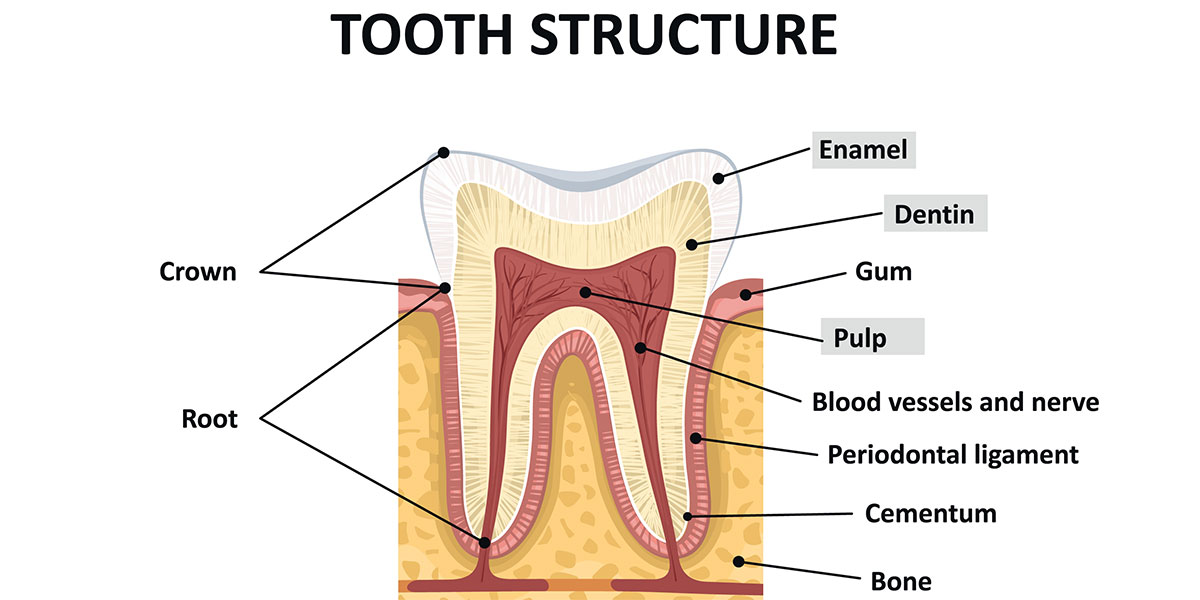What Is Root Canal Treatment?
September 25, 2018
What is a Root Canal?
Root canal treatment is also known as Endodontic treatment and refers to treatment inside of a tooth. To easier understand what a root canal is, we will look at the structure of a tooth itself.
The outside of a tooth consists of enamel (white part above the gum level).
Below the enamel, a hard but elastic layer called dentin surrounds the soft tissue inside the tooth – the pulp.
The pulp contains nerves, connective tissues and blood vessels that stretch from the crown of the tooth down to one or more roots. Inside each root, there is one or more “canals” where the pulp tissues can be found.
This pulp tissue is very important for the growth and development of a tooth and once the tooth is fully grown, the pulp remains quietly inside the root(s). If the pulp gets lightly traumatised (e.g..: carious lesion on enamel and dentin) it undergoes survival cellular changes to accommodate for this “trauma” – a reversible inflamed stage.

On the contrary, if this trauma is more pronounced the pulp may get irreversibly inflamed and/or infected and it needs to be removed (root canal treatment).
Thus, the term “root canal” refers to the canal located inside a particular root harbouring a pulp tissue.
What are the treatment steps of root canal treatment?
If your diagnosis of a root canal is confirmed, your dentist will follow the steps below to treat the affected tooth. Before starting the treatment, local anaesthesia is administered.
1. Placing rubber dam to isolate the affected tooth
A rubber dam is a simple sheet of rubber. Your dentist will place a rubber dam to isolate and surround the tooth. The rubber dam is placed to act as a barrier to keep the affected tooth dry, clean, and contaminate-free during root canal treatment.
2. Access cavity & pulp tissue inspection
In the second step, your dentist will drill a small hole into the tooth to get access to the pulp tissue. This is called creating an “access cavity”. Your dentist will examine the pulp tissue and may use a surgical operating microscope to get a greater overview of the tooth’s root canals.
3. Cleaning the root canal
In the third step, your dentist will use fine needles which are called endodontic files to reduce microorganisms, their toxins, and other debris from the root canal system. These files are made of nickel titanium. This makes them extremely flexible and strong, which is necessary to clean the circumferential walls of the root canal.
4. Sealing the tooth
Once disinfected, the canal is filled with a sealer and a natural rubber called Gutta-Percha (root canal filling). A provisional or final restorative material may be used to seal off the access cavity depending on your treatment plan.
The root canal filling material can only be seen via an x-ray taken by your dentist and it looks like you have a “white” cone inside the tooth.
Who can treat root canals?
Any dentist can provide you with root canal treatment. However, there are occasions where a referral to an Endodontist (a root canal specialist) is recommended due to challenges or when the risk of failure is higher.
Root Canal Cost
The cost for root canal treatment usually depends on the amount of root canals located. Furthermore, the level of difficulty encountered during planning or treatment is also taken into account. If you are a private health fund member with major dental extras, your insurance will usually cover part of the treatment costs.
In any case, your dentist will give you a treatment plan including a detailed quote at your consultation.
Is root canal treatment painful?
No, it should not be! Local anaesthesia is used to completely numb the tooth and area. There are situations, however, where a pulp tissue is severely inflamed and local anaesthetics may not work completely. Antibiotics may then be considered to calm the tooth/area down.
Aftercare and what to expect after root canal treatment
Root canal treatment as with any dental treatment may leave the area with a “bruised” sensation for a few days after. Analgesics are commonly used to prevent and control major discomfort.
Numbness may still be present when you leave the office. Thus, you should be mindful not to bite down on your lips, cheeks or tongue and avoid eating foods until you regain your feeling in your mouth, tongue and lips.
In some cases, the tooth will require a full coverage (like a crown) for long-term results.
Root Canal Treatment at Dental Implants & Aesthetics
Dr Mateus De Mello has a special interest in root canal treatment. You can book a consultation with Dr De Mello online here or call our friendly team on 07 5503 1701.















